《大学英语跨文化交际》课程教案
大学英语中高级课程-跨文化交际教案

大学英语中高级课程《跨文化交际》电子教案Week1 Culture and Intercultural Communication (I)I. Teaching objectives1. To get to understand what is culture and what is intercultural communication2. To get to understand different metaphors of culture3. 4. To understand how culture governs people‘s speech and behaviorsII. Classroom activities1.Brainstorming activity: What are the things that come up in your mind when you think of―Chinese culture‖?2.Definitions of culture—E.B.Tylor (1871) in Primitive Culture: ―that complex wh ole which includes knowledge, belief, art, morals, law, custom and any other capabilities and habits acquired by man as a member of a society.‖—Lustig & Koester: ―Culture is a learned set of shared perceptions about beliefs, values, and norms, which affec t the behaviors of a relatively large group of people‖—Gudykunst: Culture is our theory of the game being played in our society. We use our theory of the game being played in interacting with the other people we encounter. It tells us how to communicate with others and how to interpret their behavior. We generally are not highly aware of the rules of the game being played, but we behave as though there is general agreement on the rules.—Anthropologists: the total way of living3.Cultural mini-drama:Situation: Wang Liang worked in a Sino-German Joint V enture. One day, on his way to the coffee machine, he found that Wolfgang, one of his German colleagues, had seemingly gotten rather involved in a newspaper. Out of curiosity, Wang came up to Wolfgang so he could glance at the newspaper. Then he asked, ―Which one are you reading? Is it interesting?‖Mini-drama: What will happen to them then? Put students into several groups to perform the drama.The latter part of the drama: But all of a sudden, Wolfgang lost his temper, began to complain about Wang's invasion of his privacy, and demanded an apology for him. Wang felt rather upset, and kept explaining that he had not realized his behavior was rude. After this, whenever Wang stepped toward Wolfgang, he would soon cover up what he was doing, or stand up to keep a clear distance with Wang. Wang Liang got very confused, wondering why his friendly behaviors aroused such hostility in his colleague.4.Metaphors of culture—Culture is like the water a fish swims in, the sky a bird flies in, and the air people live in.—Culture is the software of our mind.—Culture is the grammar of our behavior.—Culture is like an iceberg.5.Classification of culture—high culture—popular culture—deep culture6.Movie clip appreciation—characters—key words•abuse n. mistreatment•attorney n. lawyer 律师•bruise n. an injury that shows up as a discoloration on the skin 瘀伤;擦伤•chitchat n. light informal conversation•conjecture n. a hypothesis that has little hard evidence•hearing n. a legal proceeding where evidence is taken for the purpose of determining an issue of fact and reaching a decision based on that evidence 听证会•incontrovertible n. impossible to deny or disprove•indisputably adv. cannot be disputed•inflict v. impose something unpleasant 施以;加害•ludicrous adj. inviting laughter荒谬的;可笑的•neglect n. lack of attention and due care•pending adj. waiting to be decided or settled•speculation n. a guess based on incomplete evidence•testimony n. something that serves as evidence—Phrases and expressions•put the cart before the horse: t o have things in the wrong order本末倒置—Cultural notes•CW A: Child Welfare Agency, a government organization intended to protect the rights of children•Guasha treatment (scraping therapy): A traditional Chinese medical treatment in which a wooden board repeatedly slides across the patient‘s acupuncture points. Itworks on the basis of principles similar to those of acupuncture and massage. Thus,ailments that can be treated by acupuncture and massage can be helped withGuasha as well. It can help reestablish the human body‘s natural biologi calcirculation.•ER: emergency room•―Show me‖ state: A nickname for Missouri, a midwestern state in the central United States. This term appears on automobile license plates for Missouri.—Pairwork exercises7.Explore interculturally(group discussion and presentation)—In the hearing, why does Xu Datong invite John to be his lawyer although John is not familiar with family law? What can you learn from it about Chinese culture?—Why doesn‘t John defend Xu Datong in the hearing? What ca n you learn from this?—Why does Xu Datong tell the judge he performed Guasha on Dennis? What can we learn from this about Chinese culture?8.Intercultural communication: Communication between people from different culturalbackground.III. Assignments1. Explain the metaphors of culture.2. Cite some daily examples to illustrate how culture governs people‘s speech and behaviors.Week2 Culture and Intercultural Communication (II)I. Teaching objectives1. to get to learn various classifications of culture2. to get to understand what is intercultural communication3. to get to understand why we should study intercultural communicationII. Classroom activities1.Check the assignments of last week.—Explain the metaphors of culture.—Cite some examples to illustrate how culture governs people‘s speech and behaviors.2. A social survey: Culture shapes people‘s view.3.Classifications of culturea)High culture, popular culture, deep cultureb)Big culture, small culturec)Mainstream culture, subcultured)Eastern culture, western culturee)Eastern culture, Indian culture, western culture (梁漱溟)f)Eastern culture, Indian culture, Arabic culture, European culture (季羡林)g)Food culture, wine culture, tea culture etc.4.Case studyQuestions for discussion:—Why didn‘t the man change the sea t as required by the stewardess?—What can you learn from it about Chinese culture?—Any other comments about the case?5.What is intercultural communication?—Communication between people from different cultural background.6.Why study intercultural communication?Let there be a small country with few people…Though neighboring communities overlook one anotherand the crowing of cocks and barking of dogs canbe heard, yet the people there may grow old anddie without ever visiting one another----- Lao Tze《老子》:―甘其食,美其服,安其居,乐其俗。
大学英语跨文化交际教案
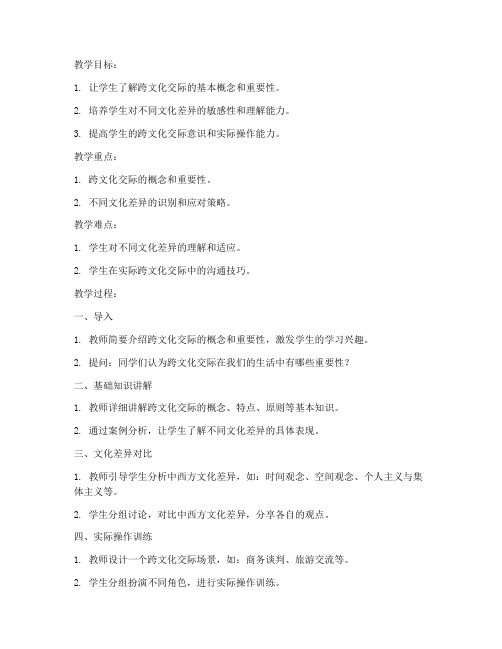
教学目标:1. 让学生了解跨文化交际的基本概念和重要性。
2. 培养学生对不同文化差异的敏感性和理解能力。
3. 提高学生的跨文化交际意识和实际操作能力。
教学重点:1. 跨文化交际的概念和重要性。
2. 不同文化差异的识别和应对策略。
教学难点:1. 学生对不同文化差异的理解和适应。
2. 学生在实际跨文化交际中的沟通技巧。
教学过程:一、导入1. 教师简要介绍跨文化交际的概念和重要性,激发学生的学习兴趣。
2. 提问:同学们认为跨文化交际在我们的生活中有哪些重要性?二、基础知识讲解1. 教师详细讲解跨文化交际的概念、特点、原则等基本知识。
2. 通过案例分析,让学生了解不同文化差异的具体表现。
三、文化差异对比1. 教师引导学生分析中西方文化差异,如:时间观念、空间观念、个人主义与集体主义等。
2. 学生分组讨论,对比中西方文化差异,分享各自的观点。
四、实际操作训练1. 教师设计一个跨文化交际场景,如:商务谈判、旅游交流等。
2. 学生分组扮演不同角色,进行实际操作训练。
3. 教师观察并指导,帮助学生提高跨文化交际技巧。
五、总结与反思1. 教师总结本节课的重点内容,强调跨文化交际的重要性。
2. 学生分享自己在实际操作训练中的收获和体会。
3. 教师针对学生的表现进行点评和指导。
教学资源:1. 多媒体课件:跨文化交际基本知识、文化差异对比案例等。
2. 文化差异对比表格:中西方文化差异对比。
3. 跨文化交际场景模拟案例。
教学评价:1. 课堂参与度:观察学生在课堂上的发言、讨论和实际操作表现。
2. 知识掌握情况:通过课堂提问和课后作业检查学生对跨文化交际基本知识的掌握程度。
3. 实际操作能力:评价学生在跨文化交际场景模拟中的表现,如沟通技巧、应对策略等。
教学反思:1. 教师根据学生的反馈,调整教学策略,提高教学效果。
2. 教师关注学生在跨文化交际中的实际需求,提供针对性的指导。
3. 教师鼓励学生积极参与跨文化交际实践,提高跨文化交际能力。
跨文化交际教案(5篇范文)
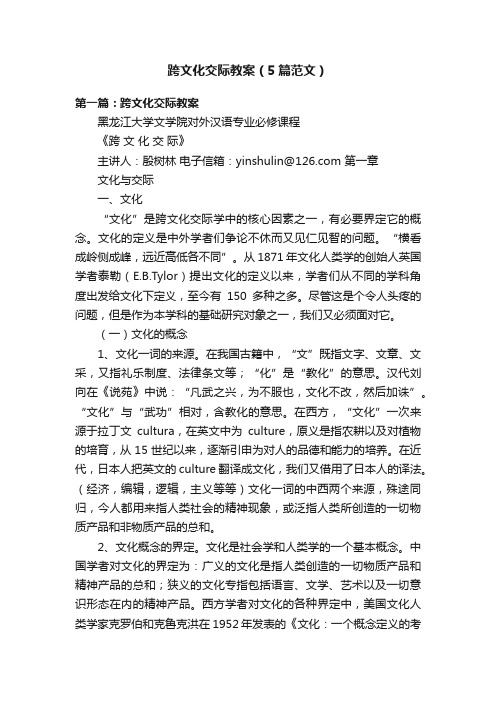
跨文化交际教案(5篇范文)第一篇:跨文化交际教案黑龙江大学文学院对外汉语专业必修课程《跨文化交际》主讲人:殷树林电子信箱:*****************第一章文化与交际一、文化“文化”是跨文化交际学中的核心因素之一,有必要界定它的概念。
文化的定义是中外学者们争论不休而又见仁见智的问题。
“横看成岭侧成峰,远近高低各不同”。
从1871年文化人类学的创始人英国学者泰勒(E.B.Tylor)提出文化的定义以来,学者们从不同的学科角度出发给文化下定义,至今有150多种之多。
尽管这是个令人头疼的问题,但是作为本学科的基础研究对象之一,我们又必须面对它。
(一)文化的概念1、文化一词的来源。
在我国古籍中,“文”既指文字、文章、文采,又指礼乐制度、法律条文等;“化”是“教化”的意思。
汉代刘向在《说苑》中说:“凡武之兴,为不服也,文化不改,然后加诛”。
“文化”与“武功”相对,含教化的意思。
在西方,“文化”一次来源于拉丁文cultura,在英文中为culture,原义是指农耕以及对植物的培育,从15世纪以来,逐渐引申为对人的品德和能力的培养。
在近代,日本人把英文的culture翻译成文化,我们又借用了日本人的译法。
(经济,编辑,逻辑,主义等等)文化一词的中西两个来源,殊途同归,今人都用来指人类社会的精神现象,或泛指人类所创造的一切物质产品和非物质产品的总和。
2、文化概念的界定。
文化是社会学和人类学的一个基本概念。
中国学者对文化的界定为:广义的文化是指人类创造的一切物质产品和精神产品的总和;狭义的文化专指包括语言、文学、艺术以及一切意识形态在内的精神产品。
西方学者对文化的各种界定中,美国文化人类学家克罗伯和克鲁克洪在1952年发表的《文化:一个概念定义的考评》中提出的定义为多数人所接受。
他们在分析了100多种文化定义后,把文化定义为:文化存在于各种内隐和外显的模式之中,借助于符号的运用得以学习和传播,并构成人类群体的特殊成就,这些成就包括他们制造物品的各种具体式样,文化的基本要素是传统(通过历史衍生和由选择得到的)思想观念和价值,其中尤以价值观最为重要。
《大学英语跨文化交际教程》教学大纲
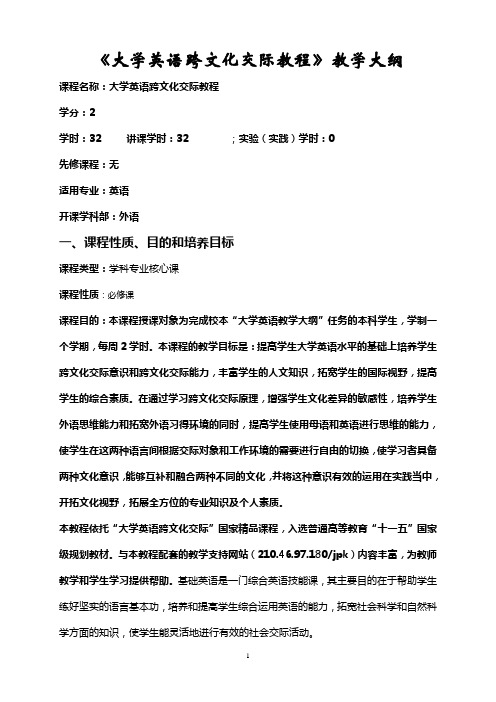
《大学英语跨文化交际教程》教学大纲课程名称:大学英语跨文化交际教程学分:2学时:32 讲课学时:32;实验(实践)学时:0先修课程:无适用专业:英语开课学科部:外语一、课程性质、目的和培养目标课程类型:学科专业核心课课程性质:必修课课程目的:本课程授课对象为完成校本“大学英语教学大纲”任务的本科学生,学制一个学期,每周2学时。
本课程的教学目标是:提高学生大学英语水平的基础上培养学生跨文化交际意识和跨文化交际能力,丰富学生的人文知识,拓宽学生的国际视野,提高学生的综合素质。
在通过学习跨文化交际原理,增强学生文化差异的敏感性,培养学生外语思维能力和拓宽外语习得环境的同时,提高学生使用母语和英语进行思维的能力,使学生在这两种语言间根据交际对象和工作环境的需要进行自由的切换,使学习者具备两种文化意识,能够互补和融合两种不同的文化,并将这种意识有效的运用在实践当中,开拓文化视野,拓展全方位的专业知识及个人素质。
本教程依托“大学英语跨文化交际”国家精品课程,入选普通高等教育“十一五”国家级规划教材。
与本教程配套的教学支持网站(210.46.97.180/jpk)内容丰富,为教师教学和学生学习提供帮助。
基础英语是一门综合英语技能课,其主要目的在于帮助学生练好坚实的语言基本功,培养和提高学生综合运用英语的能力,拓宽社会科学和自然科学方面的知识,使学生能灵活地进行有效的社会交际活动。
培养目标:使学生在课程结束时基本具备语篇阅读理解能力,2500左右词汇量;基本掌握英语常用句型,具备基本的口头与笔头表达能力。
二、课程内容和建议学时分配本课程教学内容主要包括三个方面:首先,基础理论。
本课程对跨文化交际理论进行系统的、深入浅出的介绍,使学生对学习跨文化交际的必要性和重要性有理性的认识。
虽然跨文化交际是一门新兴学科,但理论并不匮乏,本课程通过对Sapir-Wolf, EdwardHall, Scollon R., Larry A.Samover, Richard E.Porter, Geert Hofstede, Lisa A.Stefani, Fon Trompanar, Kluckhohn, Strodtbeck,等学者提出的跨文化交际理论的讲解增强学生的跨文化交际意识,使学生对跨文化交际这门学科的理论有所了解。
跨文化交际课大学英语教案
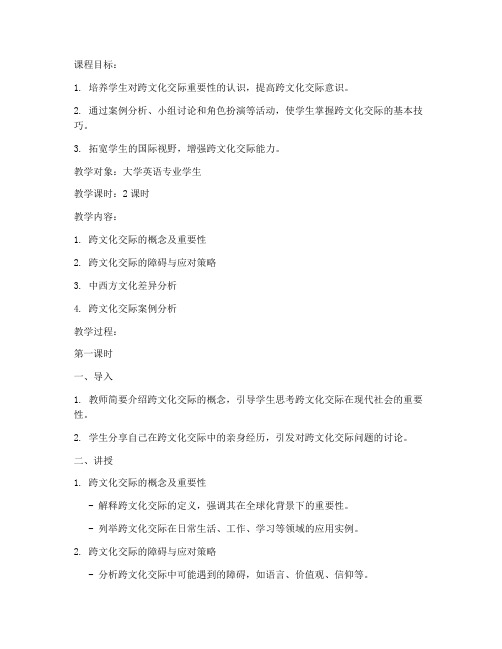
课程目标:1. 培养学生对跨文化交际重要性的认识,提高跨文化交际意识。
2. 通过案例分析、小组讨论和角色扮演等活动,使学生掌握跨文化交际的基本技巧。
3. 拓宽学生的国际视野,增强跨文化交际能力。
教学对象:大学英语专业学生教学课时:2课时教学内容:1. 跨文化交际的概念及重要性2. 跨文化交际的障碍与应对策略3. 中西方文化差异分析4. 跨文化交际案例分析教学过程:第一课时一、导入1. 教师简要介绍跨文化交际的概念,引导学生思考跨文化交际在现代社会的重要性。
2. 学生分享自己在跨文化交际中的亲身经历,引发对跨文化交际问题的讨论。
二、讲授1. 跨文化交际的概念及重要性- 解释跨文化交际的定义,强调其在全球化背景下的重要性。
- 列举跨文化交际在日常生活、工作、学习等领域的应用实例。
2. 跨文化交际的障碍与应对策略- 分析跨文化交际中可能遇到的障碍,如语言、价值观、信仰等。
- 介绍应对策略,如尊重差异、了解文化背景、提高跨文化意识等。
三、案例分析1. 教师展示中西方文化差异的案例,如饮食、节日、礼仪等。
2. 学生分组讨论,分析案例中的文化差异及其影响。
3. 每组派代表分享讨论成果,教师点评并总结。
四、角色扮演1. 教师提供情景,学生分组进行角色扮演,模拟跨文化交际的场景。
2. 角色扮演结束后,各小组分享体验,教师点评并总结。
第二课时一、复习1. 教师回顾上一节课的内容,检查学生对跨文化交际概念、障碍与应对策略的掌握程度。
2. 学生提问,教师解答。
二、讲授1. 中西方文化差异分析- 深入分析中西方文化在价值观、思维方式、交际方式等方面的差异。
- 结合具体案例,引导学生思考文化差异对跨文化交际的影响。
2. 跨文化交际技巧- 教授学生在跨文化交际中应遵循的原则,如尊重、耐心、倾听等。
- 通过案例分析,使学生了解如何运用跨文化交际技巧解决实际问题。
三、总结1. 教师总结本节课的主要内容,强调跨文化交际的重要性。
《大学英语(跨文化交际英语)》课程教学大纲

《大学英语(跨文化交际英语)》课程教学大纲CROSS-CULTURAL COMMUNICATION执笔者:吴勇审核人:易强编写日期:2017年10月二、课程简述《大学英语(跨文化交际英语)》课程是我校非英语专业本科基础阶段的公共基础课,属必修课程。
该课程安排在第三学期,总计48学时,3学分。
本课程根据教育部《大学英语教学指南》(2014)及我校人才培养定位实际要求来确定其教学内容和制订其教学大纲。
三、课程的性质、目的和任务教育部《大学英语教学指南》(2014)指出,大学英语课程具有人文性,体现在跨文化教育,培养跨文化交际能力,强调西方文化和中国文化意识并重。
开设《跨文化交际英语》课程,旨在培养学生的应用能力,增强跨文化交际意识和交际能力,同时发展自主学习能力,提高综合文化素养,培养学生国际意识。
《大学英语(跨文化交际英语)》课程是我校非英语专业本科基础阶段的公共基础课,属必修课程。
课程通过学习跨文化交际基础理论,分析跨文化交际案例,提高跨文化交际意识,并在语言学习的同时,更多关注英语国家的文化,特别是通过与汉语文化的对比,提高跨文化交际能力,以适应社会发展和国际交流的需要。
跨文化交际能力主要包括三方面:语言运用能力,相关国家文化和专业背景知识,以及交流能力三方面。
通过本课程学习,学生应当比较熟悉英语国家文化,以及汉英文化的差异,掌握跨文化交际的基本知识和技巧,进而提高自己运用英语进行跨文化交际的能力。
四、课程教学环节的基本要求(一)大学英语课程教学总体要求依照教育部《大学英语教学指南》(2014),大学英语课程教学要求分为三个层次,即基础目标、提高目标和发展目标。
基础目标针对英语高考成绩合格的学生,是本科毕业时应达到的基本要求;提高目标和发展目标针对大学入学时英语已达到较好水平的学生,也是对学生英语应用能力要求较高的专业所选择的要求。
三个级别教学要求的总体能力描述如下:三个级别教学要求的语言单项技能描述如下:展目标为教学目标,而英语基础较差的普通本科、艺术班、专升本等专业原则上以基础目标为起点进行教学。
大学英语教案:跨文化交际能力培养的项目设计

大学英语教案:跨文化交际能力培养的项目设计引言大学英语课程不仅关注语言技能的培养,也要注重培养学生的跨文化交际能力。
随着全球化的进程,跨文化交流变得越来越重要,并在各个领域中得到广泛应用。
培养学生的跨文化交际能力不仅可以帮助他们更好地理解不同文化的差异,还可以提高他们在国际舞台上的竞争力。
因此,在大学英语教学中引入跨文化交际能力培养的项目是必要的。
跨文化交际能力的重要性了解不同的文化背景学习跨文化交际能力可以帮助学生了解不同文化背景对人们的影响。
不同的文化有着不同的价值观、信仰和行为准则。
通过学习不同文化的差异,学生可以更好地理解他人的行为,并且能够更好地适应不同的环境。
提高沟通能力跨文化交际能力可以帮助学生提高他们的沟通能力。
在跨文化交际中,语言并不是唯一的交流方式,非语言因素和文化背景也起着重要的作用。
通过学习跨文化交际能力,学生可以更好地理解和运用非语言交流方式,如肢体语言、面部表情和姿势等,从而有效地进行跨文化交流。
拓展国际视野跨文化交际能力可以拓展学生的国际视野。
在全球化时代,很多行业都对跨文化交际能力有较高的要求。
通过培养学生的跨文化交际能力,他们可以更好地适应全球化的环境,开阔国际视野,并在国际舞台上更好地展示自己的能力。
跨文化交际能力培养的项目设计项目目标该跨文化交际能力培养项目的目标是通过学习和实践,提高学生的跨文化交际能力。
项目的重点是让学生了解不同文化背景的差异,并能够在跨文化环境中有效地进行交流和合作。
通过项目的实施,学生将能够培养出丰富的国际视野,提高沟通技巧,增强自信心,并且能够更好地适应多元文化的环境。
项目内容该项目包括以下几个主要内容:1. 学习跨文化理论在项目开始阶段,学生将学习一些跨文化交际的理论知识。
这包括跨文化传播的概念、跨文化沟通的基本原则和技巧等。
通过学习跨文化理论,学生可以更好地了解跨文化交际的重要性和需要注意的问题。
2. 获取跨文化信息在项目的第二阶段,学生将通过多种途径获取跨文化信息。
《大学英语(跨文化交际英语)》课程教学大纲

《大学英语(跨文化交际英语)》课程教学大纲CROSS-CULTURAL COMMUNICATION执笔者:吴勇审核人:易强编写日期:2017年10月二、课程简述《大学英语(跨文化交际英语)》课程是我校非英语专业本科基础阶段的公共基础课,属必修课程。
该课程安排在第三学期,总计48学时,3学分。
本课程根据教育部《大学英语教学指南》(2014)及我校人才培养定位实际要求来确定其教学内容和制订其教学大纲。
三、课程的性质、目的和任务教育部《大学英语教学指南》(2014)指出,大学英语课程具有人文性,体现在跨文化教育,培养跨文化交际能力,强调西方文化和中国文化意识并重。
开设《跨文化交际英语》课程,旨在培养学生的应用能力,增强跨文化交际意识和交际能力,同时发展自主学习能力,提高综合文化素养,培养学生国际意识。
《大学英语(跨文化交际英语)》课程是我校非英语专业本科基础阶段的公共基础课,属必修课程。
课程通过学习跨文化交际基础理论,分析跨文化交际案例,提高跨文化交际意识,并在语言学习的同时,更多关注英语国家的文化,特别是通过与汉语文化的对比,提高跨文化交际能力,以适应社会发展和国际交流的需要。
跨文化交际能力主要包括三方面:语言运用能力,相关国家文化和专业背景知识,以及交流能力三方面。
通过本课程学习,学生应当比较熟悉英语国家文化,以及汉英文化的差异,掌握跨文化交际的基本知识和技巧,进而提高自己运用英语进行跨文化交际的能力。
四、课程教学环节的基本要求(一)大学英语课程教学总体要求依照教育部《大学英语教学指南》(2014),大学英语课程教学要求分为三个层次,即基础目标、提高目标和发展目标。
基础目标针对英语高考成绩合格的学生,是本科毕业时应达到的基本要求;提高目标和发展目标针对大学入学时英语已达到较好水平的学生,也是对学生英语应用能力要求较高的专业所选择的要求。
三个级别教学要求的总体能力描述如下:三个级别教学要求的语言单项技能描述如下:针对我校实际情况,一本招生及二本招生中英语水平较好的专业原则上以提高目标和发展目标为教学目标,而英语基础较差的普通本科、艺术班、专升本等专业原则上以基础目标为起点进行教学。
大学英语跨文化交际 chapter2
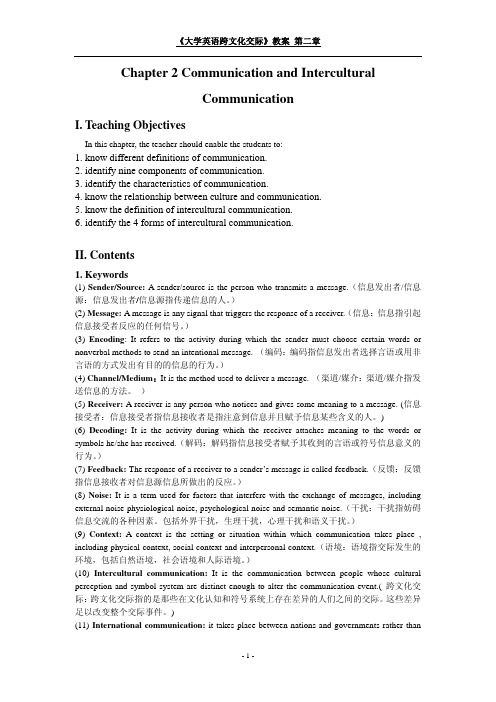
Chapter 2 Communication and InterculturalCommunicationI. Teaching ObjectivesIn this chapter, the teacher should enable the students to:1. know different definitions of communication.2. identify nine components of communication.3. identify the characteristics of communication.4. know the relationship between culture and communication.5. know the definition of intercultural communication.6. identify the 4 forms of intercultural communication.II. Contents1. Keywords(1) Sender/Source: A sender/source is the person who transmits a message.(信息发出者/信息源:信息发出者/信息源指传递信息的人。
)(2) Message: A message is any signal that triggers the response of a receiver.(信息:信息指引起信息接受者反应的任何信号。
)(3) Encoding: It refers to the activity during which the sender must choose certain words or nonverbal methods to send an intentional message. (编码:编码指信息发出者选择言语或用非言语的方式发出有目的的信息的行为。
跨文化chapter1
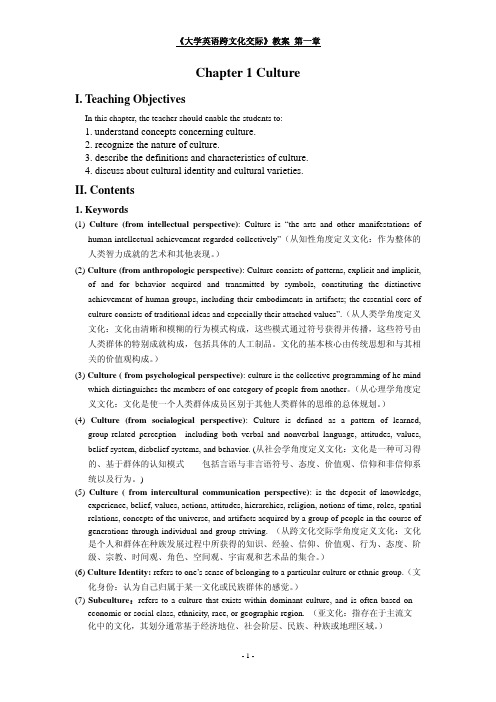
Chapter 1 CultureI. Teaching ObjectivesIn this chapter, the teacher should enable the students to:1. understand concepts concerning culture.2. recognize the nature of culture.3. describe the definitions and characteristics of culture.4. discuss about cultural identity and cultural varieties.II. Contents1. Keywords(1) Culture (from intellectual perspective): Culture is “the arts and other manifestations ofhuman intellectual achievement regarded collectively”(从知性角度定义文化:作为整体的人类智力成就的艺术和其他表现。
)(2) Culture (from anthropologic perspective): Culture consists of patterns, explicit and implicit,of and for behavior acquired and transmitted by symbols, constituting the distinctive achievement of human groups, including their embodiments in artifacts; the essential core of culture consists of traditional ideas and especially their attached values”.(从人类学角度定义文化:文化由清晰和模糊的行为模式构成,这些模式通过符号获得并传播,这些符号由人类群体的特别成就构成,包括具体的人工制品。
大学英语跨文化阅读教程1教案

课程目标:1. 培养学生阅读英语跨文化材料的能力,提高阅读速度和理解力。
2. 增强学生对不同文化背景下的语言和表达方式的认识。
3. 培养学生分析跨文化交际中可能出现的误解和冲突,提高跨文化交际能力。
教学对象:大学英语专业或非英语专业学生教学时间:2课时教学内容:1. 导入话题:介绍跨文化交际的重要性,以及阅读跨文化材料对提高交际能力的作用。
2. 阅读材料:选取一篇适合大学英语水平、具有跨文化特点的短文。
3. 阅读理解:引导学生分析文章内容,理解文章中的跨文化元素。
4. 课堂讨论:围绕文章内容展开讨论,让学生发表自己的观点,培养批判性思维。
5. 文化对比:对比中西方文化差异,分析文化差异对交际的影响。
6. 总结与反思:总结本节课所学内容,引导学生反思跨文化交际的重要性。
教学过程:一、导入话题(5分钟)1. 教师简要介绍跨文化交际的定义和重要性。
2. 提问:为什么阅读跨文化材料对提高交际能力很重要?二、阅读材料(10分钟)1. 教师发放阅读材料,要求学生在规定时间内阅读完毕。
2. 提问:阅读完毕后,大家对文章有什么初步印象?三、阅读理解(15分钟)1. 教师引导学生分析文章内容,包括主题、观点、论据等。
2. 提问:文章中哪些地方体现了跨文化元素?四、课堂讨论(15分钟)1. 教师提出与文章相关的讨论问题,如:- 文章中提到的文化差异有哪些?- 这些文化差异对交际有何影响?- 如何克服这些文化差异,提高跨文化交际能力?2. 学生分组讨论,每组选派代表发言。
五、文化对比(10分钟)1. 教师列举中西方文化差异的例子,引导学生分析这些差异对交际的影响。
2. 提问:在中西方文化差异中,哪些差异最容易导致误解?六、总结与反思(5分钟)1. 教师总结本节课所学内容,强调跨文化交际的重要性。
2. 引导学生反思:自己在跨文化交际中遇到过哪些困难,如何克服这些困难?教学评价:1. 课堂参与度:观察学生在课堂讨论中的表现,评估其跨文化交际意识和能力。
大学英语跨文化交际 chapter2

Chapter 2 Communication and InterculturalCommunicationI. Teaching ObjectivesIn this chapter, the teacher should enable the students to:1. know different definitions of communication.2. identify nine components of communication.3. identify the characteristics of communication.4. know the relationship between culture and communication.5. know the definition of intercultural communication.6. identify the 4 forms of intercultural communication.II. Contents1. Keywords(1) Sender/Source: A sender/source is the person who transmits a message.(信息发出者/信息源:信息发出者/信息源指传递信息的人。
)(2) Message: A message is any signal that triggers the response of a receiver.(信息:信息指引起信息接受者反应的任何信号。
)(3) Encoding: It refers to the activity during which the sender must choose certain words or nonverbal methods to send an intentional message. (编码:编码指信息发出者选择言语或用非言语的方式发出有目的的信息的行为。
大学英语教案:跨文化交际与国际合作

大学英语教案: 跨文化交际与国际合作一、引言本教案旨在帮助大学生提高跨文化交际能力和培养国际合作意识。
通过对不同文化之间的差异和相似之处进行探索,学生将能够更好地理解和应对跨文化交际中的各种挑战。
二、教学目标1.了解跨文化交际的重要性和必要性。
2.掌握跨文化交际的基本原则和技巧。
3.培养尊重他人文化差异和包容心态。
4.学习如何与国际团队合作并有效沟通。
5.提高英语口语表达和听力理解能力。
三、教学内容3.1 跨文化交际概述•定义跨文化交际•探讨世界上不同文化之间的差异,并举例说明3.2 跨文化交际的原则•尊重他人文化差异•避免刻板印象和歧视行为•建立信任关系•善于妥协与调节3.3 跨文化交际技巧•学习并尊重他人的礼仪和文化习惯•处理文化冲突的策略•发展跨文化沟通能力:非语言表达、谈判技巧等3.4 国际合作与团队协作•理解国际合作的意义与挑战•培养国际合作能力:团队协作、有效沟通等3.5 英语口语表达与听力训练•练习英语口语表达,包括发音和流利度•提高听力理解能力,特别是针对不同语境和口音四、教学活动和方法1.小组讨论:学生分组讨论不同文化之间的差异,并分享自身经历。
2.角色扮演:学生在模拟跨文化交际场景中扮演不同角色,锻炼应对能力。
3.实地考察或虚拟体验:参观多元文化社区、网上交流平台等,体验真实的跨文化交际环境。
4.分组项目:学生分成国际团队,进行跨文化合作项目,加强团队合作和沟通技巧。
五、评估方式1.课堂表现:包括参与讨论、提问和回答问题的能力。
2.小组项目成果评估:根据合作项目的成果和演示展示,评估学生的团队协作和跨文化交际能力。
3.口头报告:要求学生就所学内容进行口头报告,评估其英语口语表达和听力理解能力。
六、教材和资源•主教材:《跨文化交际与国际合作教程》•教学辅助资源:录音机、投影仪、互联网资源等七、参考资料1.Gudykunst, W.B., & Kim, Y.Y. (2017). Bridging Differences: EffectiveIntergroup Communication (4th edition). Sage Publications.2.Jandt, F.E. (2017). An Introduction to Intercultural Communication:Identities in a Global Community (9th edition). Sage Publications. (以上为此次教案的大致内容,可以根据实际情况进行进一步细化和调整)。
大学英语教案:跨文化交际与全球化
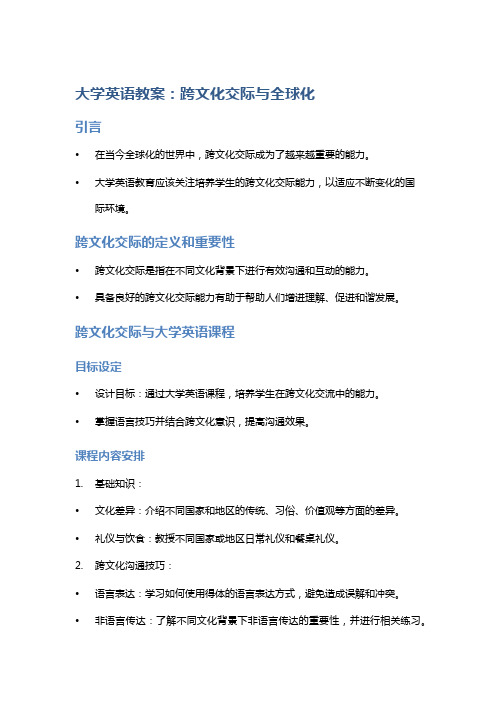
大学英语教案:跨文化交际与全球化引言•在当今全球化的世界中,跨文化交际成为了越来越重要的能力。
•大学英语教育应该关注培养学生的跨文化交际能力,以适应不断变化的国际环境。
跨文化交际的定义和重要性•跨文化交际是指在不同文化背景下进行有效沟通和互动的能力。
•具备良好的跨文化交际能力有助于帮助人们增进理解、促进和谐发展。
跨文化交际与大学英语课程目标设定•设计目标:通过大学英语课程,培养学生在跨文化交流中的能力。
•掌握语言技巧并结合跨文化意识,提高沟通效果。
课程内容安排1.基础知识:•文化差异:介绍不同国家和地区的传统、习俗、价值观等方面的差异。
•礼仪与饮食:教授不同国家或地区日常礼仪和餐桌礼仪。
2.跨文化沟通技巧:•语言表达:学习如何使用得体的语言表达方式,避免造成误解和冲突。
•非语言传达:了解不同文化背景下非语言传达的重要性,并进行相关练习。
3.文化舞台剧表演:•学生参与编写和表演一场跨文化舞台剧,以提高他们的创作能力和对不同文化的理解。
教学方法•案例分析:通过分析真实案例,让学生理解并掌握跨文化交际中可能出现的挑战。
•角色扮演:模拟不同情境下的跨文化交流,并给予反馈和指导。
全球化对跨文化交际的影响•全球化使得跨国企业、留学等活动大量增加,跨文化交际能力变得日益必要。
•对于大学英语教育来说,全球化意味着需要更加全面地关注不同国家和地区的文化差异。
结论•大学英语教育应该紧密结合跨文化交际,培养学生在全球化时代所需的能力。
•通过设计合适的教学方法和内容,大学英语教案能有效帮助学生提高跨文化交际能力。
大三选修课跨文化交际教案
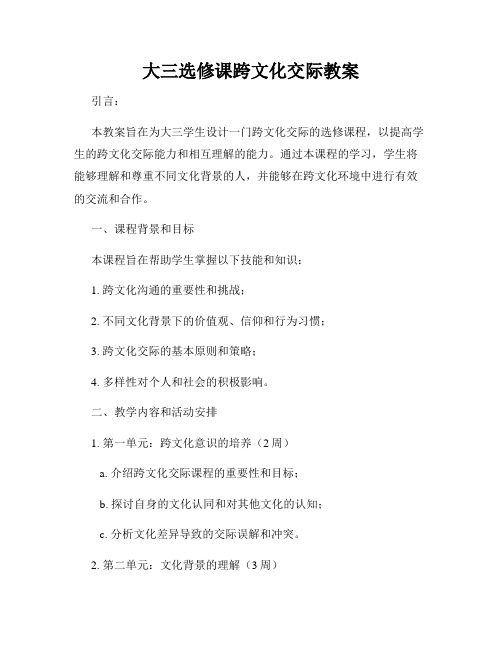
大三选修课跨文化交际教案引言:本教案旨在为大三学生设计一门跨文化交际的选修课程,以提高学生的跨文化交际能力和相互理解的能力。
通过本课程的学习,学生将能够理解和尊重不同文化背景的人,并能够在跨文化环境中进行有效的交流和合作。
一、课程背景和目标本课程旨在帮助学生掌握以下技能和知识:1. 跨文化沟通的重要性和挑战;2. 不同文化背景下的价值观、信仰和行为习惯;3. 跨文化交际的基本原则和策略;4. 多样性对个人和社会的积极影响。
二、教学内容和活动安排1. 第一单元:跨文化意识的培养(2周)a. 介绍跨文化交际课程的重要性和目标;b. 探讨自身的文化认同和对其他文化的认知;c. 分析文化差异导致的交际误解和冲突。
2. 第二单元:文化背景的理解(3周)a. 讨论不同文化背景下的价值观和行为规范;b. 分析文化冲突的原因和解决方法;c. 组织学生进行跨文化访谈或实地考察。
3. 第三单元:跨文化交际技巧(4周)a. 介绍跨文化交际的基本原则和策略;b. 引导学生学习如何适应并处理文化差异;c. 练习跨文化交际的技巧和技巧,如非语言沟通、言语礼仪等。
4. 第四单元:多样性与全球合作(3周)a. 探讨多样性对个人发展和社会进步的积极影响;b. 多元文化背景下的合作与团队建设;c. 分析全球化背景下的跨文化交际案例。
三、教学方法和评估方式1. 教学方法:本课程将采用多元化的教学方法,包括课堂讲授、学生讨论、小组活动、角色扮演、案例分析等,以激发学生的积极参与和主动学习。
2. 评估方式:a. 课堂表现和参与度:包括课堂讨论和小组活动的积极参与程度;b. 个人报告或研究论文:要求学生选择一个跨文化交际主题进行研究,并撰写一份报告或研究论文;c. 跨文化交际实践项目:要求学生进行一个跨文化交际实践项目,并撰写实践报告。
四、教材和参考资料1. 主教材:《跨文化交际导论》(第三版),作者:詹姆斯·温特·内文海姆。
《大学英语跨文化交际》课程教案

《大学英语跨文化交际》课程教案IntroductionI. 主要内容作者在本章阐述了全球化概念,文化融合和跨文化交际的相关概念。
首先,从经济学和社会学等视角把握全球化的概念,了解全球化对文化多样性的影响。
同时,论述了全球化的历史起源,阐述了现代化等概念。
在这一部分里,作者还分析了全球化的形成要素。
其次,在文化融合方面,作者从三个方面阐述了这个问题。
第一,文化多样性的论述。
介绍了在全球化过程中涌现出来的几个概念:世界文化,宏观文化和微观文化。
第二,劳动力多样性的阐述。
第三部分是关于文化多样性的弊端。
最后,作者论述了跨文化交际的相关问题。
充分论证了跨文化交际的概念,研究跨文化交际的必要性和进行有效跨文化交际的关键策略,以及跨文化培训的相关问题,从而形成理解文化差异的能力。
II. Teaching Objectives1.to identify the definitions of globalization, culture merge and intercultural communication2.to identify some relevant concepts about these three main themes3.to cultivate students to be able to recognize and analyze cultural factorsIII. Teaching Course1. Present the Cultural Phenomena to Students(1) Present some cases involving different cultural contacts between persons from different countries or different parts of the same country(2) Then lead to the concept of globalization2. Warm-up Questions1) Do you want to go abroad? What’s your aim?2) Do you find whether it’s easy or not to get along with foreign friends?3. Key terms0.1.1.a. Globalization (from economic standpoint) (从经济学角度定义全球化): It is conceived as a process of increasing involvement in international business operations. (经济学视角中的全球化表现为不断增加的国际商务往来过程)。
大学英语跨文化交际课程教案CHAPTER1
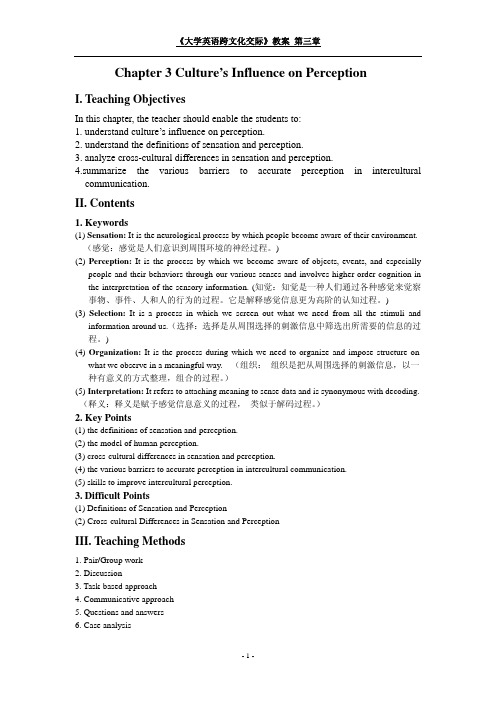
Chapter 3 Culture’s Influence on PerceptionI. Teaching ObjectivesIn this chapter, the teacher should enable the students to:1. understand culture’s influence on perception.2. understand the definitions of sensation and perception.3. analyze cross-cultural differences in sensation and perception.4.summarize the various barriers to accurate perception in intercultural communication.II. Contents1. Keywords(1) Sensation: It is the neurological process by which people become aware of their environment.(感觉:感觉是人们意识到周围环境的神经过程。
)(2) Perception: It is the process by which we become aware of objects, events, and especiallypeople and their behaviors through our various senses and involves higher-order cognition in the interpretation of the sensory information. (知觉:知觉是一种人们通过各种感觉来觉察事物、事件、人和人的行为的过程。
它是解释感觉信息更为高阶的认知过程。
- 1、下载文档前请自行甄别文档内容的完整性,平台不提供额外的编辑、内容补充、找答案等附加服务。
- 2、"仅部分预览"的文档,不可在线预览部分如存在完整性等问题,可反馈申请退款(可完整预览的文档不适用该条件!)。
- 3、如文档侵犯您的权益,请联系客服反馈,我们会尽快为您处理(人工客服工作时间:9:00-18:30)。
《大学英语跨文化交际》课程教案IntroductionI. 主要内容作者在本章阐述了全球化概念,文化融合和跨文化交际的相关概念。
首先,从经济学和社会学等视角把握全球化的概念,了解全球化对文化多样性的影响。
同时,论述了全球化的历史起源,阐述了现代化等概念。
在这一部分里,作者还分析了全球化的形成要素。
其次,在文化融合方面,作者从三个方面阐述了这个问题。
第一,文化多样性的论述。
介绍了在全球化过程中涌现出来的几个概念:世界文化,宏观文化和微观文化。
第二,劳动力多样性的阐述。
第三部分是关于文化多样性的弊端。
最后,作者论述了跨文化交际的相关问题。
充分论证了跨文化交际的概念,研究跨文化交际的必要性和进行有效跨文化交际的关键策略,以及跨文化培训的相关问题,从而形成理解文化差异的能力。
II. Teaching Objectives1.to identify the definitions of globalization, culture merge and intercultural communication2.to identify some relevant concepts about these three main themes3.to cultivate students to be able to recognize and analyze cultural factorsIII. Teaching Course1. Present the Cultural Phenomena to Students(1) Present some cases involving different cultural contacts between persons from different countries or different parts of the same country(2) Then lead to the concept of globalization2. Warm-up Questions1) Do you want to go abroad? What’s your aim?2) Do you find whether it’s easy or not to get along with f oreign friends?3. Key terms0.1.1.a. Globalization (from economic standpoint) (从经济学角度定义全球化): It is conceived as a process of increasing involvement in international business operations. (经济学视角中的全球化表现为不断增加的国际商务往来过程)。
0.1.1.b. Globalization (from sociological standpoint) (从社会学角度定义全球化): It occurswhen the constraints of geography on social and cultural arrangement recede as people around the world become increasingly aware that they are receding.0.1.1.c. Globalization (from Marxist standpoint) (从马克思主义角度定义全球化): It is what people in the third world have already experienced for several centuries. It is called colonization. (全球化是第三世界国家在这几个世纪所遭受的苦难,即殖民化。
)0.2 Caucasians(高加索人): 较新的人类学研究显示,現代人的历史先是从非洲与中东到了欧洲,然后再从欧洲到了东亚,所以高加索人(Caucasians)主要分为印欧雅利安人和闪族、含族等“挪亚的后裔”)在生命历史变动过程中,总是界与东方人和黑人之间。
如上所述,现代三大人种的形成,得力于两次分裂:第一次经历了“非洲人与异非洲人之间”(between Africans and non─Africans)的分裂,第二次经历了“东方人与高加索人之间”(between Orientals and Caucasians)的分裂.0.2 Hispanic:It came into common use as a result of the 1980 Census to identify various U.S Spanish-speakers’ shared roots to Spain. It refers to that population segment with the capability of speaking and comprehending the Spanish language, whose ancestry is based in aSpanish-speaking country, and who identify with Hispanic cultures. 1980年人口普查时开始通用的称呼。
主要指讲西班牙语、祖先来自讲西班牙语的国家并且认同西班牙文化的人。
0.2.1. a. World culture(世界文化):It is the idea that as traditional barriers among people of differing cultures break down, emphasizing the commonality of human needs, one culture will emerge, a new culture to which all people will adhere. 世界文化指的是一种的新文化。
不同文化背景所带来的传统隔阂消除后,就会产生强调人类需求共性的,受到全人类拥护的世界文化。
0.2.1. b. Macroculture(宏观文化): It implies losing ethnic difference and forming one large society. 宏观文化意味着种族差异的消失和更大的社会的形成0.2.1. b. Melting pot(大熔炉): It means a sociocultural assimilation of people of differing backgrounds and nationalities. 大熔炉指不同背景和国籍的人们之间的社会文化的同化.尽管大熔炉这一比喻所内涵的文化意义是动态的,但它从来都不能很精确的表达美国文化的意义。
确切地讲,美国社会的不同文化融为一体并变成一个独特的文化实体,在美国历史上从来都没有发生过。
实际上,美国国内的多种文化一直都相互适应,相互汲取经验,但他们从未丧失自我——各种文化一直保留着自己独特传统。
比较而言,在象征美国这一多元文化社会的比喻中,“色拉盘”是最好的形式。
就象色拉中的不同种类的成分一样,美国社会中的不同群体文化相互平等、独立,相互依存。
这是现代美国社会的现实,也是发展的必然趋势。
0.2.2. Diversity(多样性): It refers to the mix of people from various backgrounds in the labor force. 多样性是指在劳动力中,具有不同背景的人们的混合体。
0.2.3 b. Stereotype(文化定势): It is used to refer to negative or positive judgments made about individuals based on any observable or believed group membership.0.3.1 Intercultural communication(跨文化交际): It involves communication between people of different culture. 是指来自不同文化背景的人们之间的交际。
4. Supplementary Case and material.Supplementary English case:0.1.1.a. Global corporations such as AOL-Time Warner and McDonald’s are seen as undermining local culture. Because the United States has promoted both free markets and democracy throughout the world, global market are perceived as reinforcing U.S wealth and dominance.0.2.2 ⑴ Chinese business values also emphasize kinship, interpersonal connections, respect for elders, and hierarchy. These values are a result of three decades of Communism, which stresses a collectivistic society. Despite a recent move to a market economy, factories and larger businesses in China still reflect past collectivistic characteristic characteristics. For example, in the collectivistic society, the government provides jobs for all well as cradle-to-grave welfare for workers and their families. This system in China is known as “the Iron Rice Bowl”.⑵Dominant managerial values in the United States include “achievement and success, belief in hard work, pragmatism, Puritanism, rationality, impersonality in interpersonal work relationships, equality of opportunity, acceptance of competition, and individualism.”中文补充案例及材料:0.2.3.b. stereotype(文化定势):法国人浪漫,德国人严格,美国人随便,日本人敬业。
